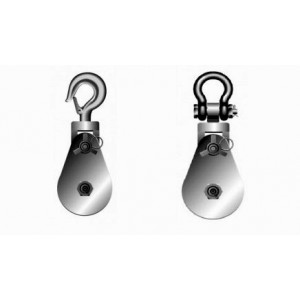
Snatch blocks are used to enhance the pulling capacity of a winch, sometimes by up to as much as double the pulling power - this can be very useful when you need to lift heavy items.
With so much choice, choosing a snatch block can be complex so it’s well worth doing your research before making a purchase.
This guide explains everything you need to know about snatch blocks, how to use them and the safety procedures that need to be followed in order to safely use snatch blocks.
Snatch blocks are a heavy-duty pulley inside a metal casing, primarily designed for lifting heavy goods and extending the lifting capacity of other lifting devices, such as winches or cable pullers, for smoother lifting with ease. They act as the connection between the load and the lifting device and are used with wire or fibre rope, and are most ideal for transporting loads over small distances.
Through a choice of different fittings, snatch blocks can be attached to anchor points, with different models offering different means of securing the unit in place for safe and secure lifting. By off-setting the anchor point, you are also able to change the direction of a winch’s cable.
Snatch blocks are used by mounting them to a secure surface, and installing the rope or cable into the snatch block and mounting it to the desired item that you need to lift. Snatch blocks have a handy feature of allowing the side plate to be moved; meaning that you don’t need to feed the cable through the opening, but instead slot it in through the side plate then re attach. This enables snatch blocks to be set up and utilised much quicker than a sheave block which doesn't have the removable plate so the cables need to be threaded through which can be more time consuming.
In order to use the snatch block, feed the winch line into the snatch block and make sure that it is secured, then mount the snatch block to a strong and stable surface (or it can be anchored around a stable pillar or mount. Once the winch is secured to the snatch block, safely mount the end of the winch to the desired item that needs to be lifted; you may then begin to use the winch to lift or pull the object. The snatch block adds leverage to the pulling capacity which allows large loads to be lifted easily.
A good example of how a snatch block works, imagine that a large vehicle is stuck in the snow, but a standard winch doesn’t have the pulling capacity to safely pull the vehicle from the snow. A snatch block can be anchored to a strongly anchored object such as a nearby tree, the addition of the snatch block mounted to the tree would then allow you to change the direction of the winch, and increase the pulling power, thus moving the heavy vehicle from the snow.
With any safety equipment, procedures must be followed in order to safe operation and to prolong the life in the equipment. When using snatch blocks, this is no different. Snatch blocks can be dangerous when used incorrectly, so it’s crucial that you understand what you’re doing and the importance of regular safety checks.
With snatch blocks generally used for lifting large amounts of weight, it’s vital that equipment is set up properly with all components attached securely, this can be done by checking that the surface the snatch block is mounted to will be able to take the increased pressure, that the mounting hooks used to attach the winch to the desired object are within their capacity and also ensuring that the winch itself is in good condition.
Snatch blocks are a middleman between the winch, and the object that needs to be lifted - this means that there is an incredible amount of weight on the snatch block. Snatch blocks are made from very strong metals which can take extreme weights - but always check the specifications of the specific snatch block being used to check that it is safe to use for the item you are lifting. It is also worth double-checking that the side plate of the snatch block has been securely fastened before engaging the winch - you can check the torque specification of the bolt to ensure that it is safely secured.
Each pulley block in this category is built to last using the best materials available and with the most precise attention to detail, as you would expect from products sold by Lifting Gear Direct. We endeavour to offer kits from popular brands which meet industry standards.
We also make our own brand equipment, including jib cranes and gantry systems which can be used in conjunction with our snatch blocks and other items if you need something seriously special for your setup. you are sure to avoid disappointment when you order with us.
Buy a snatch block or sheave block at great prices from Lifting Gear Direct today.